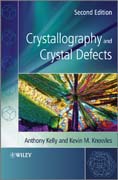
The aim of the new edition of Crystallography and Crystal Defects will be to communicate the modern concepts of crystallography in a clear, succinct, manner and to put these concepts into use in the description of line and planar defects in crystalline materials, quasicrystals and crystal interfaces. The book will begin with a chapter on lattice geometry. The second and third chapters will present crystal systems and crystal structures. Tensors, stresses, strain and elasticity and plasticity in crystals will be discussed in chapters four to six, respectively. Chapters 7 and 8 will be dedicated to dislocations and dislocations in crystals. Point defects, deformation twinning and martensitic transformations will be covered in chapters nine to eleven. The book will conclude with a chapter on interfaces in crystals and the appendices. INDICE: Preface xiii Section I Perfect Crystals 1 1 Lattice Geometry 3 1.1The Unit Cell 3 1.2 Lattice Plane and Directions 7 1.3 The Weiss Zone Law 11 1.4 Symmetry Elements 14 1.4.1 Translational Symmetry 15 1.4.2 Rotational Symmetry 15 1.4.3 Reflection Symmetry 16 1.5 Restrictions on Symmetry Elements 16 1.6 Possible Combinations of Rotational Symmetries 21 1.7 Crystal Systems 26 1.8 Space Lattices (Bravais Lattices) 26 Problems 37 Suggestions for Further Reading 40 References 41 2 Point Groups and Space Groups 43 2.1 Macroscopic Symmetry Elements 43 2.2 Orthorhombic System 49 2.3 Tetragonal System 52 2.4 CubicSystem 53 2.5 Hexagonal System 56 2.6 Trigonal System 59 2.7 Monoclinic System 63 2.8 Triclinic System 65 2.9 Special Forms in the Crystal Classes 67 2.10 Enantiomorphous Crystal Classes 68 2.11 Laue Groups 69 2.12 Space Groups 69 2.13 Nomenclature for Point Groups and Space Groups 78 2.14 Groups, Subgroups and Supergroups 79 2.15 An Example of a Three-Dimensional Space Group 79 Problems 82 Suggestions for Further Reading 84 References 84 3 Crystal Structures 85 3.1 Introduction 85 3.2 Common Metallic Structures 86 3.2.1 Cubic Close-Packed(Fm3 m) 86 3.2.2 Hexagonal Close-Packed (P63 /mmc) 90 3.2.3 Double Hexagonal Close-Packed (P63 /mmc) 92 3.2.4 Body-Centred Cubic (Im3 m) 92 3.3 Related Metallic Structures 93 3.3.1 Indium (I4/mmm) 93 3.3.2 Mercury (R3 m) 94 3.3.3 b-Sn (I41/amd) 94 3.4 Other Elements and Related Compounds 95 3.4.1 Diamond (Fd3 m) 95 3.4.2 Graphite (P63 /mmc) 95 3.4.3 Hexagonal Boron Nitride (P63 /mmc) 973.4.4 Arsenic, Antimony and Bismuth (R3 m) 97 3.5 Simple MX and MX2 Compounds98 3.5.1 Sodium Chloride, NaCl (Fm3 m) 98 3.5.2 Caesium Chloride, CsCl (Pm3 m) 99 3.5.3 Sphalerite, a-ZnS (F4 3m) 100 3.5.4 Wurtzite, b-ZnS (P63mc) 101 3.5.5 Nickel Arsenide, NiAs (P63/mmc) 101 3.5.6 Calcium Fluoride, CaF2 (Fm3 m) 102 3.5.7 Rutile, TiO2 (P42/mnm) 103 3.6 Other Inorganic Compounds 104 3.6.1 Perovskite (Pm3 m) 104 3.6.2 a-Al2O3 (R3 c), FeTiO3 (R3 ) and LiNbO3 (R3c) 105 3.6.3 Spinel (Fd3 -m), Inverse Spinel and Related Structures 106 3.6.4 Garnet (Ia3 d) 107 3.6.5 Calcite, CaCO3 (R3 c) 109 3.7 Interatomic Distances 110 3.8 Solid Solutions 110 3.9 Polymers 113 3.10 Additional Crystal Structures and their Designation 116 Problems 119 Suggestions for Further Reading 121 References 122 4 Amorphous Materials and Special Types of CrystalSolid Aggregate 123 4.1 Introduction 123 4.2 Amorphous Materials 123 4.3 Liquid Crystals 126 4.3.1 Nematic Phases 127 4.3.2 Cholesteric Phases 129 4.3.3 Smectic Phases 129 4.4 Geometry of Polyhedra 129 4.5 Icosahedral Packing 134 4.6 Quasicrystals 135 4.6.1 A Little Recent History and a New Definition 136 4.7 Incommensurate Structures137 4.8 Foams, Porous Materials and Cellular Materials 137 Problems 139 Suggestions for Further Reading 139 References 140 5 Tensors 141 5.1 Nature of a tensor 141 5.2 Transformation of components of a vector 142 5.3 Dummy Suffix Notation 145 5.4 Transformation of Components of
- ISBN: 978-0-470-75015-5
- Editorial: John Wiley & Sons
- Encuadernacion: Cartoné
- Páginas: 552
- Fecha Publicación: 13/01/2012
- Nº Volúmenes: 1
- Idioma: Inglés
